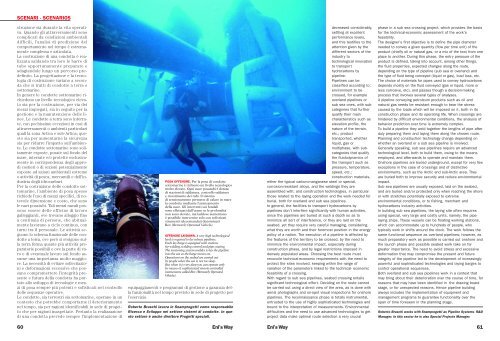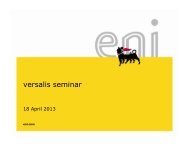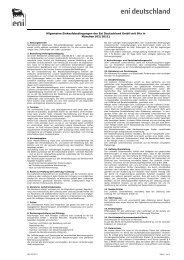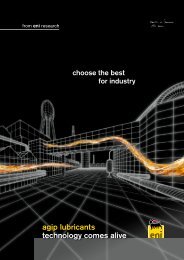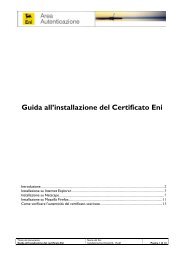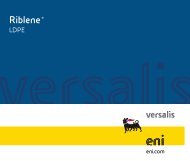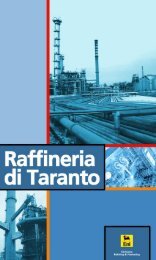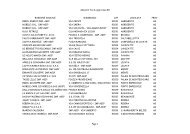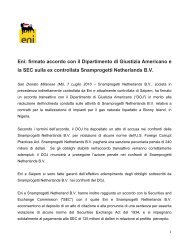È in corso il restauro conservativo del Duomo di Milano. Un ... - Eni
È in corso il restauro conservativo del Duomo di Milano. Un ... - Eni
È in corso il restauro conservativo del Duomo di Milano. Un ... - Eni
Create successful ePaper yourself
Turn your PDF publications into a flip-book with our unique Google optimized e-Paper software.
SCENARI - SCENARIOS<br />
struzione sia durante la vita operativa.<br />
Quando gli attraversamenti sono<br />
complicati da con<strong>di</strong>zioni ambientali<br />
<strong>di</strong>ffic<strong>il</strong>i, l’analisi <strong>di</strong> pre<strong>di</strong>zione <strong>del</strong><br />
comportamento nel tempo è estremamente<br />
complessa e articolata.<br />
La costruzione <strong>di</strong> una condotta è realizzata<br />
saldando tra loro le barre <strong>di</strong><br />
tubo opportunamente preparate e<br />
adagiandole lungo un per<strong>corso</strong> predef<strong>in</strong>ito.<br />
La progettazione e la tecnologia<br />
<strong>di</strong> costruzione variano a seconda<br />
che si tratti <strong>di</strong> condotte a terra o<br />
sottomar<strong>in</strong>e.<br />
In genere le condotte sottomar<strong>in</strong>e richiedono<br />
un livello tecnologico elevato<br />
sia per la costruzione, per via dei<br />
mezzi impiegati, sia <strong>in</strong> seguito per la<br />
gestione e la manutenzione <strong>del</strong>le l<strong>in</strong>ee.<br />
Le condotte a terra sono <strong>in</strong>terrate,<br />
con pochissime eccezioni <strong>in</strong> casi <strong>di</strong><br />
attraversamenti o ambienti particolari<br />
quali la zona Artica e sub-Artica; questo<br />
sia per aumentarne la sicurezza<br />
sia per ridurre l’impatto sull’ambiente.<br />
Le condotte sottomar<strong>in</strong>e sono solitamente<br />
esposte, posate sul fondo <strong>del</strong><br />
mare, <strong>in</strong>terrate e/o protette esclusivamente<br />
<strong>in</strong> corrispondenza degli appro<strong>di</strong><br />
costieri o <strong>di</strong> sezioni potenzialmente<br />
esposte ad azioni ambientali estreme<br />
o attività <strong>di</strong> pesca, mercant<strong>il</strong>i e <strong>del</strong>l’<strong>in</strong>dustria<br />
degli idrocarburi.<br />
Per la costruzione <strong>del</strong>le condotte sottomar<strong>in</strong>e,<br />
l’ambiente <strong>di</strong> posa spesso<br />
richiede l’uso <strong>di</strong> mezzi specifici, <strong>di</strong> notevole<br />
<strong>di</strong>mensione e costo, che sono<br />
le navi posatubi. Tali mezzi navali possono<br />
essere <strong>del</strong>le offic<strong>in</strong>e <strong>di</strong> lavoro<br />
galleggianti, ove trovano alloggio f<strong>in</strong>o<br />
a cent<strong>in</strong>aia <strong>di</strong> persone, che abitualmente<br />
lavorano a ciclo cont<strong>in</strong>uo, con<br />
turni tra <strong>il</strong> personale. Le attività seguono<br />
lo schema funzionale <strong>del</strong>le condotte<br />
a terra, ove però si svolgono sulla<br />
terra ferma quante più attività preparatorie<br />
possib<strong>il</strong>i e ove la parte <strong>di</strong> varo<br />
e <strong>di</strong> eventuale lavoro sul fondo assume<br />
una importanza molto maggiore.<br />
La necessità <strong>di</strong> evitare sollecitazioni<br />
e deformazioni eccessive che possano<br />
compromettere l’<strong>in</strong>tegrità presente<br />
e futura <strong>del</strong>la condotta ha portato<br />
allo sv<strong>il</strong>uppo <strong>di</strong> tecnologie e mezzi<br />
<strong>di</strong> posa sempre più potenti e sofisticati nel controllo<br />
<strong>del</strong>le sequenze operative.<br />
Le condotte, sia terrestri sia sottomar<strong>in</strong>e, operano <strong>in</strong> un<br />
contesto che potrebbe comportarne <strong>il</strong> deterioramento<br />
nel tempo, sia per ragioni identificab<strong>il</strong>i <strong>in</strong> sede <strong>di</strong> progetto<br />
che per ragioni <strong>in</strong>aspettate. Pertanto la realizzazione<br />
<strong>di</strong> una condotta prevede sempre l’implementazione <strong>di</strong><br />
60<br />
POSA OFFSHORE. Per la posa <strong>di</strong> condotte<br />
sottomar<strong>in</strong>e è richiesto un livello tecnologico<br />
molto elevato. Ogni nave posatubi è dotata<br />
<strong>di</strong> stazioni <strong>di</strong> saldatura, controllo saldature<br />
e rivestimento dei tubi. Il sistema<br />
<strong>di</strong> tensionamento permette <strong>di</strong> calare <strong>in</strong> mare<br />
la condotta me<strong>di</strong>ante l’avanzamento<br />
<strong>del</strong>la nave. Gli <strong>in</strong>terventi sui fondali<br />
sono effettuati dall’uomo se le profon<strong>di</strong>tà<br />
non sono elevate, ma laddove aumentano<br />
è possib<strong>il</strong>e <strong>in</strong>tervenire solo con sofisticati<br />
strumenti telecomandati denom<strong>in</strong>ati<br />
Rov (Remotely Operated Vehicle).<br />
OFFSHORE LAYDOWN. A very high technological<br />
level is required to lay subsea pipel<strong>in</strong>es.<br />
Each lay-barge is equipped with stations<br />
for weld<strong>in</strong>g, weld<strong>in</strong>g control and pipe coat<strong>in</strong>g.<br />
The tension<strong>in</strong>g system enables to lay the pipel<strong>in</strong>e<br />
<strong>in</strong>to the sea as the barge moves on.<br />
Operations on the seabed are carried out<br />
by people when the sea is not too deep.<br />
But when it is very deep you can operate only<br />
by means of sophisticated remote-controlled<br />
<strong>in</strong>struments called Rov (Remotely Operated<br />
Vehicle).<br />
equipaggiamenti e programmi <strong>di</strong> gestione a garanzia <strong>del</strong>la<br />
funzionalità nel tempo previsto <strong>in</strong> sede <strong>di</strong> progetto per<br />
l’esercizio.<br />
Roberto Bruschi lavora <strong>in</strong> Snamprogetti come responsab<strong>il</strong>e<br />
Ricerca e Sv<strong>il</strong>uppo nel settore sistemi <strong>di</strong> condotte. In questo<br />
settore è anche <strong>di</strong>rettore Progetti speciali.<br />
<strong>Eni</strong>’s Way<br />
decreased considerably,<br />
settl<strong>in</strong>g at excellent<br />
performance levels,<br />
and this testifies to the<br />
attention given by the<br />
<strong>di</strong>fferent sectors of the<br />
<strong>in</strong>dustry to<br />
technological <strong>in</strong>novation<br />
to transport<br />
hydrocarbons by<br />
pipel<strong>in</strong>e.<br />
Pipel<strong>in</strong>es can be<br />
classified accord<strong>in</strong>g to:<br />
environment to be<br />
crossed, for example<br />
overland pipel<strong>in</strong>es or<br />
sub sea ones, with subcategories<br />
that further<br />
qualify their ma<strong>in</strong><br />
characteristics such as<br />
elevation prof<strong>il</strong>e, the<br />
nature of the terra<strong>in</strong>,<br />
etc.; product<br />
transported, whether<br />
liquid, gas or<br />
multiphase, with subcategories<br />
that qualify<br />
the fluidodynamics of<br />
the transport such as<br />
pressure, temperature,<br />
speed, etc.;<br />
construction materials,<br />
either the typical carbon-manganese steel or special,<br />
corrosion-resistant alloys, and the weld<strong>in</strong>gs they are<br />
assembled with; and construction technologies, <strong>in</strong> particular<br />
those related to the lay<strong>in</strong>g operation and the work needed for<br />
burial, both for overland and sub sea pipel<strong>in</strong>es.<br />
In general, the fac<strong>il</strong>ities to transport hydrocarbons by<br />
pipel<strong>in</strong>es don’t <strong>in</strong>terfere significantly with human activities,<br />
s<strong>in</strong>ce the pipel<strong>in</strong>es are buried at such a depth so as to<br />
m<strong>in</strong>imize all sort of <strong>in</strong>terference, or they are laid on the<br />
seabed, yet they require very careful manag<strong>in</strong>g, consider<strong>in</strong>g<br />
what they are worth and their foremost position <strong>in</strong> the energy<br />
policy of a nation. The execution of a pipel<strong>in</strong>e is affected by<br />
the features of the territory to be crossed, by the need to<br />
m<strong>in</strong>imize the environmental impact, especially dur<strong>in</strong>g<br />
construction phase, and by legal restrictions imposed <strong>in</strong><br />
densely populated areas. Choos<strong>in</strong>g the best route must<br />
reconc<strong>il</strong>e technical-economic requirements with the need to<br />
protect the sites <strong>in</strong>volved, keep<strong>in</strong>g with<strong>in</strong> the range of<br />
variation of the parameters l<strong>in</strong>ked to the technical- economic<br />
feasib<strong>il</strong>ity of a cross<strong>in</strong>g.<br />
With regard to sub sea pipel<strong>in</strong>es, seabed cross<strong>in</strong>g enta<strong>il</strong>s<br />
significant technological effort. Decid<strong>in</strong>g on the route cannot<br />
be carried out us<strong>in</strong>g a <strong>di</strong>rect view of the area, as is done with<br />
aerial photographs and on-spot visual <strong>in</strong>spections for onshore<br />
pipel<strong>in</strong>es. The reconnaissance phase is totally <strong>in</strong>strumental,<br />
entrusted to the use of highly sophisticated technologies and<br />
bound to the <strong>in</strong>terpretation of measurements. Environmental<br />
<strong>di</strong>fficulties and the need to use advanced technologies to get<br />
project data make optimal route selection a very crucial<br />
<strong>Eni</strong>’s Way<br />
phase <strong>in</strong> a sub sea cross<strong>in</strong>g project, which provides the basis<br />
for the technical-economic assessment of the work’s<br />
feasib<strong>il</strong>ity.<br />
The designer’s first objective is to def<strong>in</strong>e the pipe <strong>di</strong>ameter<br />
needed to convey a given quantity (flow per time unit) of the<br />
product (chiefly o<strong>il</strong> or natural gas, or a mix of the two) from one<br />
place to another. Dur<strong>in</strong>g this phase, the entry pressure of the<br />
product is def<strong>in</strong>ed, tak<strong>in</strong>g <strong>in</strong>to account, among other th<strong>in</strong>gs,<br />
the fluid properties, expected changes along the route,<br />
depend<strong>in</strong>g on the type of pipel<strong>in</strong>e (sub sea or overland) and<br />
the type of fluid be<strong>in</strong>g conveyed (liquid or gas), load loss, etc.<br />
The choice of materials for pipes used to convey hydrocarbons<br />
depends mostly on the fluid conveyed (gas or liquid, more or<br />
less corrosive, etc), and passes though a decision-mak<strong>in</strong>g<br />
process that <strong>in</strong>volves several types of analyses.<br />
A pipel<strong>in</strong>e convey<strong>in</strong>g petroleum products such as o<strong>il</strong> and<br />
natural gas needs be resistant enough to bear the stress<br />
caused by the loads which w<strong>il</strong>l be imposed on it, both <strong>in</strong> its<br />
construction phase and its operat<strong>in</strong>g life. When cross<strong>in</strong>gs are<br />
h<strong>in</strong>dered by <strong>di</strong>fficult environmental con<strong>di</strong>tions, the analysis of<br />
behavior pre<strong>di</strong>ction over time is extremely complex.<br />
To bu<strong>il</strong>d a pipel<strong>in</strong>e they weld together the lengths of pipe after<br />
duly prepar<strong>in</strong>g them and lay<strong>in</strong>g them along the chosen route.<br />
Plann<strong>in</strong>g and construction technology change depend<strong>in</strong>g on<br />
whether an overland or a sub sea pipel<strong>in</strong>e is <strong>in</strong>volved.<br />
Generally speak<strong>in</strong>g, sub sea pipel<strong>in</strong>es require an advanced<br />
technological level, both to bu<strong>il</strong>d them, ow<strong>in</strong>g to the means<br />
employed, and afterwards to operate and ma<strong>in</strong>ta<strong>in</strong> them.<br />
Onshore pipel<strong>in</strong>es are buried underground, except for very few<br />
exceptions <strong>in</strong> the case of cross<strong>in</strong>gs and of <strong>di</strong>st<strong>in</strong>ctive<br />
environments, such as the Arctic and sub-Arctic area. They<br />
are buried both to improve security and reduce environmental<br />
impact.<br />
Sub sea pipel<strong>in</strong>es are usually exposed, laid on the seabed,<br />
and are buried and/or protected only when reach<strong>in</strong>g the shore<br />
or with stretches potentially exposed to extreme<br />
environmental con<strong>di</strong>tions, or to fish<strong>in</strong>g, merchant and<br />
hydrocarbons <strong>in</strong>dustry activities.<br />
In bu<strong>il</strong>d<strong>in</strong>g sub sea pipel<strong>in</strong>es, the lay<strong>in</strong>g site often requires<br />
us<strong>in</strong>g special, very large and costly units, namely, the pipelay<strong>in</strong>g<br />
ships. These vessels can be float<strong>in</strong>g work<strong>in</strong>g stations,<br />
which can accommodate up to hundreds of people, who<br />
typically work <strong>in</strong> shifts around the clock. The work follows the<br />
same functional sequence as overland pipel<strong>in</strong>es; however, as<br />
much preparatory work as possible is carried out onshore and<br />
the launch phase and possible seabed work take on far<br />
greater importance. The need to avoid stress and excessive<br />
deformation that may compromise the present and future<br />
<strong>in</strong>tegrity of the pipel<strong>in</strong>e led to the development of <strong>in</strong>creas<strong>in</strong>gly<br />
powerful and sophisticated technologies and lay<strong>in</strong>g barges to<br />
control operational sequences.<br />
Both overland and sub sea pipel<strong>in</strong>es work <strong>in</strong> a context that<br />
may br<strong>in</strong>g about their deterioration over the course of time, for<br />
reasons that may have been identified <strong>in</strong> the draw<strong>in</strong>g board<br />
stage, or for unexpected reasons. Hence pipel<strong>in</strong>e bu<strong>il</strong>d<strong>in</strong>g<br />
always <strong>in</strong>cludes the implementation of equipment and<br />
management programs to guarantee functionality over the<br />
span of time foreseen <strong>in</strong> the plann<strong>in</strong>g stage.<br />
Roberto Bruschi works with Snamprogetti as Pipel<strong>in</strong>e Systems- R&D<br />
Manager. In this sector he is also Special Projects Manager.<br />
61


